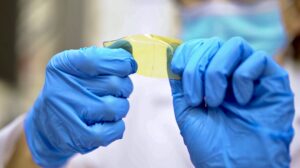The Army is working with Texas A&M University to develop 3D-printable materials for future platforms that are able to autonomously self-heal, the service said Monday.
Researchers said the stimuli-responsive polymeric materials in the future could be embedded with intelligence to autonomously adapt and reconfigure to its environment.

“The first-of-its-kind, 3-D printable and stimuli-responsive polymeric materials are expected to enable massive reconfigurability in future military platforms, which opens new opportunities for morphing unmanned air vehicles and robotic platforms,” the Army wrote in a statement.
Frank Gardea, the Army Research Laboratory’s principal investigator for the effort, said the futuristic material will have a dynamic bond allowing it go from liquid to solid multiple times, making it suitable for being 3-D printed and then recycled for new uses.
“Most cross-linked materials, especially those that are 3-D printed, tend to have a fixed form, meaning that once you manufacture your part the material cannot be reprocessed or melted,” Gardea said. “We want a system of materials to simultaneously provide structure, sensing and response.”
Current laboratory work is focused on how the material responds to temperature, with next steps expected to introduce multi-responsiveness and a range of new stimuli.
The research is still in the discovery phase, according to the Army, which noted its part of a larger exploratory push to find new scientific developments that could “disrupt current scientific and technological paradigms 30 to 50 years from now.”
Texas A&M earlier this year approved $79.3 million in funding to begin construction this fall of a new complex on its RELLIS campus that will serve as Army Futures Command’s central testing hub for next-generation technologies (Defense Daily, May 15).